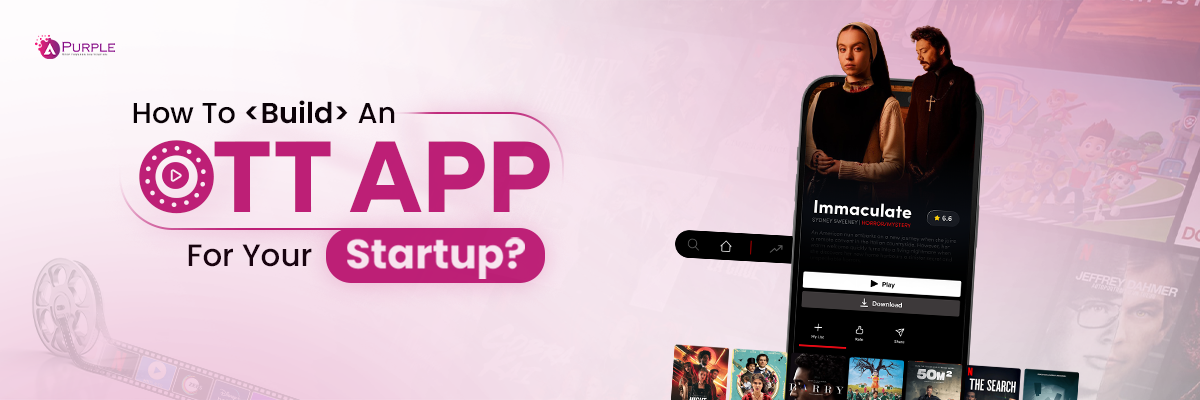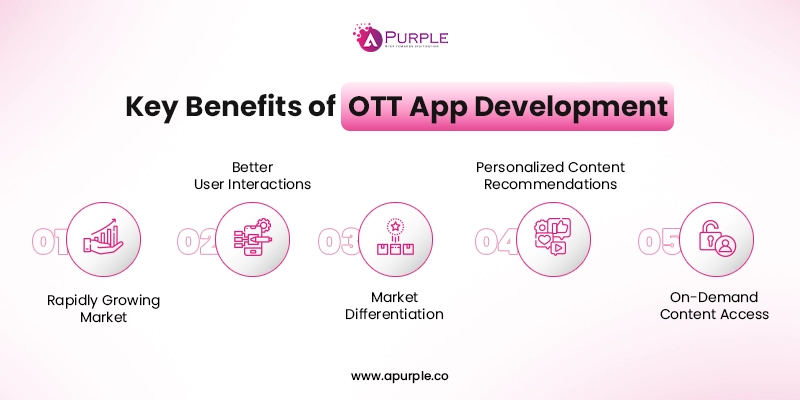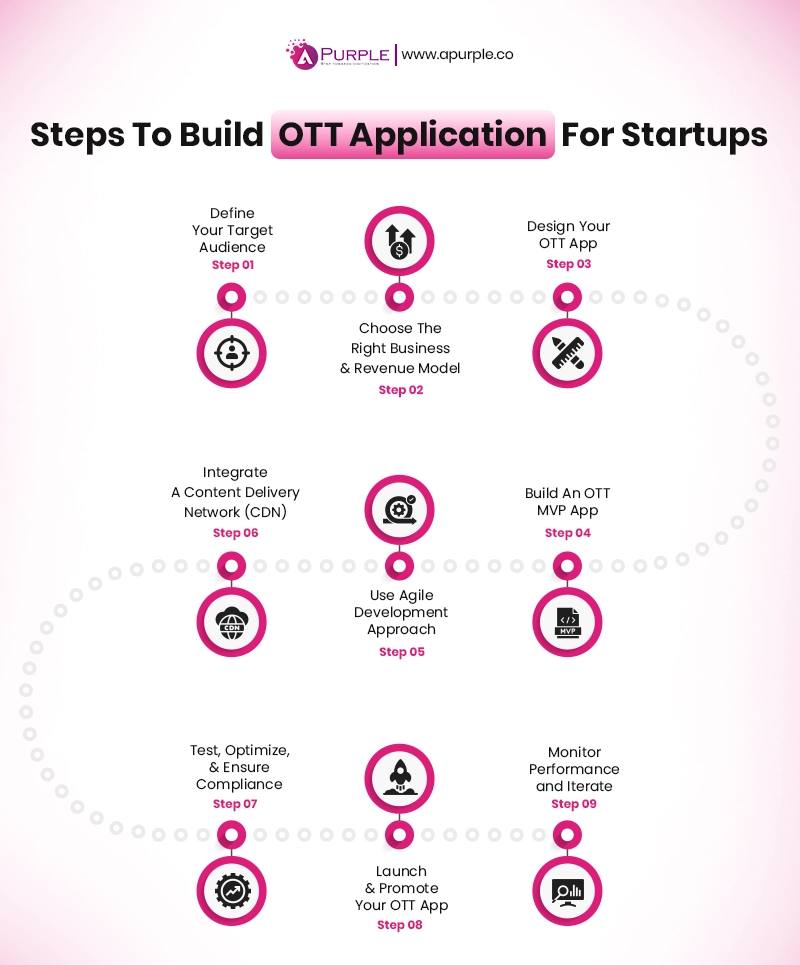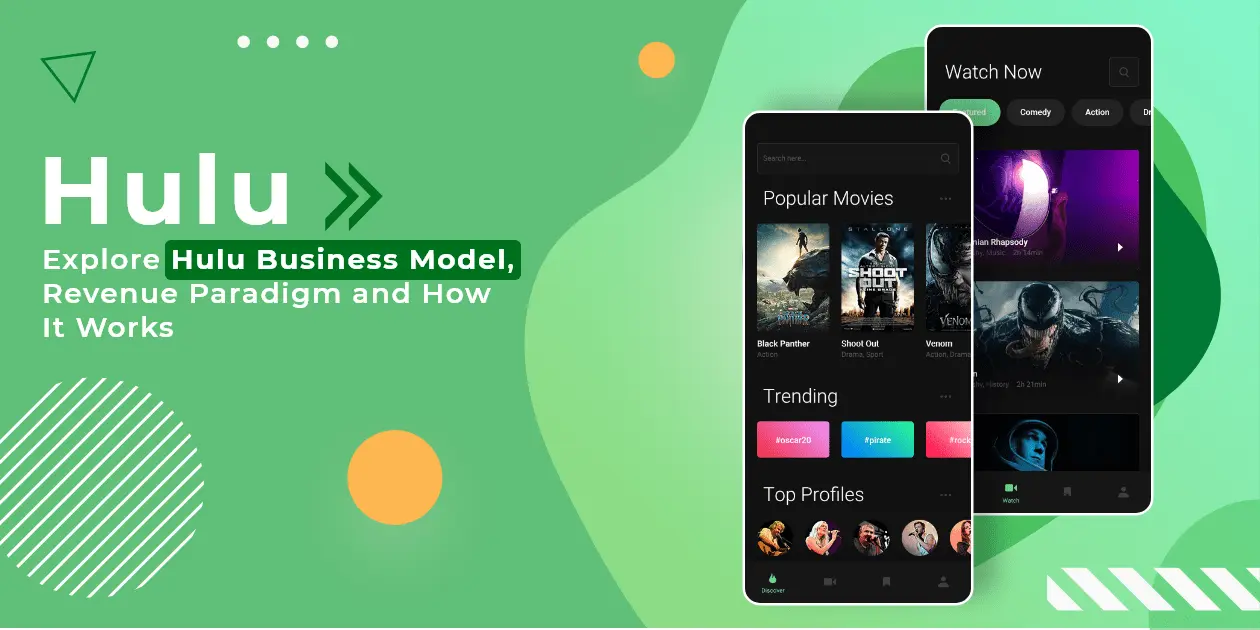
Did you know Twitch began as a simple webcam streaming app?
Also known as Justin.TV could only get 10,000 users by 2008. This is when founders noticed that one category of Justin.TV thrived in gaming. So they pivoted to a game streaming app called Twitch.TV and today it has more than 140 million users.
Twitch’s evolution highlights a crucial lesson- identifying your niche is key to successful OTT app development. Yet many founders focus on creating large content libraries instead of asking the right questions, like,
- Who is my target audience?
- What content do they engage with?
- What tech stack do I need?
- How much will OTT app development cost?
If you’re an entrepreneur asking the same questions, this guide is for you. It covers everything from the steps to OTT platform development to its features, tech stack, cost, and key compliance considerations.
Let’s first understand the basics of OTT apps.
What Is OTT App Development?
OTT app development is a process of designing, developing, and launching apps that directly deliver audio, video, and other content types to users. It also includes creating streaming systems that provide a seamless experience across devices.
Why Invest In OTT App Development in 2026?
Investing in OTT app development makes sense due to a growing market. Plus, building an OTT app can help you attract more users across demographics, which means more revenue. And giants like Netflix and Amazon Prime Video exemplify how well-built OTT apps can attract millions of users.
- The US OTT video market is expected to generate $204.84 billion by 2030, with a CAGR of 6.97%
- There will be more than 4.33 billion OTT app users in 2026, and this number will increase to 4.91 billion by 2029.
- OTT video advertising is one of the primary revenue sources for many businesses in this market, and ad-supported revenue is projected to reach $6.4 billion by the end of 2026.
- 99% of US households have subscribed to at least one streaming media app.
- OTT user penetration in the US was 60.8% in 2024 and is expected to reach 70.1% by 2029.
It is not just market potential; OTT apps development offers many other benefits, which you must consider.
What Are The Benefits of OTT App Development?
As a founder, the benefits of OTT mobile app development include a growing market, direct customer relationship, better user personalization, global reach, niche market targeting, and scalability.
- Rapid growth in the OTT market offers a substantial opportunity to tap into an industry with a consistent revenue stream.
- OTT platform development allows you to connect with the target audience directly without broadcasters acting as a middleman.
- By building a customized OTT app based on a niche audience, you can differentiate your venture by offering regional, educational, or sports content.
- Leveraging AI and Machine learning capabilities, you can create personalized content recommendations for users to improve retention.
- Modern OTT apps offer on-demand content access, ensuring higher user engagement and better monetization through a pay-per-view model.
Knowing the benefits, you must consider OTT apps development to capitalize on the market potential. However, you must first decide which type of OTT app you want to develop.
What Are The Types of OTT Apps?
OTT applications are video, music, live, gaming, messaging, and VOIP apps. The type of OTT app you choose will depend on your target audience.
| Type | Description | Examples |
|---|---|---|
| Video Streaming OTT | Provides on-demand access to Movies, TV shows, documentaries, and original content. | Netflix, Amazon Prime Video, Hulu, Disney+ |
| Audio And Music Streaming OTT | Allows users to stream music, podcasts, audiobooks, and radio content over the internet. | Spotify, Apple Music, YouTube Music |
| Live Streaming OTT | Brands or streamers can broadcast events, news, sports, or entertainment programs in real-time, which users can access through their device, and do live chat | YouTube Live, Twitch, Facebook Live |
| Messaging OTT Apps | Provide instant messaging, file sharing, and video calling over the internet | WhatsApp, Telegram |
| OTT VOIP(Voice Over Internet Protocol) Apps | Facilitates voice and video calls using the Internet protocols for personal or professional communication | Zoom, Microsoft Teams, Google Meet |
| Gaming OTT Apps | Allows gamers to play games on the app directly without needing high-end hardware. | Netflix Games |
| Social Media Streaming Apps | Combines social networking with on-demand video streaming apps to allow users to broadcast and engage with followers in real-time | Instagram Live, Facebook Live |
Once you decide which type of OTT application you want to build, you must understand how to develop it.
How To Develop An OTT App For Your Venture?
Developing an OTT app involves a structured process with multiple steps, including identifying the niche, selecting the right tech stack, choosing the best revenue stream, and developing and launching the app.
Step 1- Define Your Target Audience
As a startup founder, audience clarity is the first step in custom OTT app development. Identifying who your users are will shape what type of app you build and influence decisions like platform support and content strategy.
For example, if you’re targeting fitness enthusiasts, your OTT mobile app development should prioritize live workout streams. If your niche is regional entertainment, OTT TV app development becomes critical.
- Define what unique value(like regional, fitness, or educational content) your app will offer to the target users.
- Breakdown potential users into segments based on demographics, geographic data, psychographics, and behavioral patterns.
- Analyze your competitors based on their target audience, type of content, pricing, user reviews, and marketing strategies.
- Leverage AI-based advanced analytics, social media insights, and Google Analytics.
- Create detailed buyer personas for your ideal customers, including demographic details, interests, pain points, and viewing patterns.
- Validate persona details through AI-based market research, analyzing existing industry reports and third-party market research resources.
Check what target users say on Reddit, Quora, or YouTube comments. Use this data to gather insights using AI-based tools like ChatGPT or Perplexity. Consult startup experts for in-depth expertise in market research and audience identification.
Step 2- Choose The Right Business And Revenue Model
OTT app development requires a scalable and profitable startup business model. Some of the key OTT business and revenue models are subscription video on Demand(SVOD), Advertising Video on Demand(AVOD), Transactional Video on Demand (TVOD), and the freemium model. Your chosen business model will depend on your audience, niche market, and startup goals.
Your monetization model impacts your OTT app development cost and scalability. These models impact backend design and user acquisition strategies. This is a key aspect of OTT streaming app development, especially when scaling to new geographies or planning custom OTT app development features.
Here are the core models that you can use for your OTT app development,
| Model | Revenue Stream | Best For | Examples |
|---|---|---|---|
| SVOD | Subscription charges (monthly or annually) | Platforms with high-quality, exclusive, and original content | Netflix, Disney+ |
| AVOD | Advertisements shown during the streaming of content | Startups looking for rapid growth in a price-sensitive market | Tubi, YouTube(Free Version) |
| TVOD | A pay-per-view model where users pay for accessing specific content | Founders targeting a niche audience | Apple TV, Google Play |
| Freemium Model | Free access to users for some content, but they need to pay for exclusive titles. | Platforms are looking to grow their user base and upsell premium tiers. | Spotify |
| Hybrid Model | Combines AVOD and SVOD revenue streams. Some content is free but ad-driven, while others are behind a paywall. | Startups with an extensive library of content that can be segmented into free and premium. | Hulu, HBO Max |
Choose two to three competitors in your niche. Check their pricing pages or app stores to see how they make money. Test the most common model with a simple landing page or pre-launch signup to gauge interest.
Now that the business and revenue model is ready, create a wireframe that maps the user journey.
Step 3- Design Your OTT App
Designing your OTT app for ease of use and accessibility can improve user experience. It can also help you streamline user interactions across the UI, ensuring higher engagement. So, designing a responsive and easy-to-navigate app must be a significant part of your OTT software development plan.
Here is how you can design an OTT app optimally.
- Prioritize ease of content discovery by categorizing menus, search bars, and filters.
- Implement interactive elements that dynamically show new content available.
- Ensure seamless UI across smartphones, tablets, smart TVs, and web browsers.
- Include visual elements that make skipping, rewinding, and adaptive bitrate streaming smoother.
Use Figma to create a two—to three-screen flow based on top OTT apps like Netflix or Tubi. Then, ask three to five users to test it with a simple prototype using tools like Marvel or InVision before writing any code.
You have the design ready, but before you launch it fully, measure whether the business model is right and whether the design is market-ready.
Step 4- Build An OTT MVP App
Building a minimum viable product(MVP) means creating a smaller version of your app with essential functions. This will help validate your OTT app idea, test core features and the business model, and design responsiveness. You can quickly test your app functions using MVP development services and make changes according to user feedback.
Leverage lean startup methodology to improve using a build-measure-learn loop continuously.
Step 5- Use Agile Development Approach
The agile approach is the best way to ensure optimal OTT app development because it’s an iterative process. So you can test different features, content, and functionalities for the audience. Plus, it also helps you quickly adjust the OTT platform development strategy.
For example, if you are creating a video streaming app like Netflix, you must experiment with different content genres across regions. This means you will need an AI algorithm designed to deliver content according to the local preferences of the audience. Plus, you also need to ace the design aspect.
Creating a Netflix app design that offers multiple rows of recommended content across the main UI and categorizes content requires a strategic approach like agile. It lets you quickly adjust the new iteration based on user feedback for optimal OTT video app development.
Choose the most suitable development approach, such as native, cross-platform, and hybrid app development, for your OTT app. It will help you target specific platforms for app deployment.
Step 6- Integrate A Content Delivery Network(CDN)
Content delivery is at the core of OTT apps development. So, a major aspect of your custom OTT app development strategy should focus on optimal content delivery.
- Integrate CDNs through custom APIs and plugins to ensure seamless content delivery.
- Configure your app to route video requests through the CDN instead of your servers.
- CDNs will cache frequently accessed videos on edge servers near the user’s location.
- Set specific caching rules to ensure content that is streamed more often is always available.
- Enable adaptive streaming through bitrate adjustment to ensure quality despite lower internet speeds.
- Use CDN’s distributed network to handle peak traffic, demand, and live events.
- Implement CDN security measures like encryption, DDoS protection, and digital rights management (DRM)
Use analytics tools that many CDN vendors provide to monitor your app’s content delivery performance and optimize it based on data insights.
Step 7- Test, Optimize, and Ensure Compliance
Testing remains critical for high-quality OTT apps development, ensuring device compatibility and playback quality across platforms. You must also provide robust security and privacy standards, including compliance with evolving regulations like GDPR and region-specific data protection laws. Compliance checks should cover not only privacy but also digital accessibility and copyright enforcement.
Testing should validate AI-driven personalization features and interactive elements. Performance testing must account for adaptive bitrate streaming and cross-platform accessibility, including smart TVs, mobile, desktop, and gaming consoles.
Integrate automated testing tools for AI features and accessibility compliance. Before launch, monitor usability, load times, crash reports, and AI-driven recommendation accuracy.
Step 8- Launch and Promote Your OTT App
Launching your OTT app omnichannel promotion, leveraging both traditional and emerging platforms. Optimize app store listings with AI-powered keyword research and localize for multiple regions to maximize reach. Early-access promotions remain effective, but short-form video content is now essential for organic discovery, especially among younger audiences.
Strategic business alliances, such as telecom bundling or partnerships with content creators, can accelerate user acquisition and market penetration.
Use interactive features (polls, quizzes) within these videos to increase engagement and drive traffic to your app.
Step 9- Monitor Performance and Iterate
Monitor your app with AI-powered dashboards to track watch time, churn, subscription upgrades, and engagement with interactive features. Use real-time analytics to identify technical issues, content trends, and user preferences. Record sessions and analyze heatmaps to understand bottlenecks to user experience on your OTT app.
Pair session recording tools with AI analytics to automatically flag friction points in the user journey.
Now that you have configured the OTT app development process, you must understand what features you need to develop.
What Are The Key Features Of OTT app development?
Successful OTT app development requires a user-centric feature set to improve user experience, support monetization, and drive retention across streaming devices.
| Feature | Description | Category |
|---|---|---|
| User Registration & Profiles | Allows users to register on your OTT app | Essential |
| Advanced Video Player | Comes with advanced bitrate adjustment capabilities | Essential |
| Multi-Screen And Cross-Platform Support | Offers seamless viewing on mobile, tablet, smart TV, and browsers | Essential |
| Smart Search And Filters | Allows quick content discovery via tags, genre, language, and popularity | Essential |
| Subscription And Payment Integration | Enables monetization through SVOD, AVOD, TVOD, or hybrid models. | Essential |
| Admin Panel And CMS Integration | Backend system for managing content uploads, metadata, and scheduling. | Essential |
| Offline Viewing | Allows users to download and watch videos without internet access. | Advanced |
| Multi-language And Subtitle Support | Expands accessibility across global and regional audiences. | Advanced |
| Parental Controls | Restricts content based on user age or parental preferences. | Advanced |
| Real-Time Analytics Dashboard | Provides business insights from user behavior and content performance. | Advanced |
| Voice-enabled Search | Enables content discovery through voice commands. | Advanced |
| Content Recommendation Engine | Enhances user experience with personalized suggestions using machine learning. | Advanced |
| Dynamic Pricing And Subscription Offers | AI models help create specific pricing based on peak demand for content and customization subscription plans. | Advanced |
For entrepreneurs, identifying the features can be overwhelming. You must conduct market research, analyze competitors, and decide what your target audience demands to identify the features. However, you can take the help of an OTT app development company to identify and build features based on your target audience.
Which Technology Stack To Use For OTT App Development?
The technologies and features you choose to implement will impact the overall cost of OTT app development, so understanding the tech stack is essential.
Here is the OTT app development technology stack you can use,
| Component | Technologies/Frameworks |
|---|---|
| Frontend (Mobile) | Swift (iOS), Kotlin (Android), React Native, Flutter |
| Frontend (Web/Desktop) | Angular, React.js, Vue.js |
| Backend | Node.js, Python, ROR, .NET, Go |
| Database | MySQL, PostgreSQL, MongoDB, Cassandra |
| Cloud Infrastructure | AWS, Google Cloud, Azure |
| Streaming | HLS, WebRTC, FFmpeg, Media Encoder |
| CDN | Cloudflare, CloudFront, Azure CDN |
| Payment Gateways | Stripe, PayPal, Razorpay, Braintree |
| Analytics | Google Analytics, Mixpanel, AppDynamics |
Now that you have planned the entire OTT app development process and identified features and a tech stack, it’s time to understand the cost.
What Is The OTT App Development Cost?
The cost of OTT app development depends on various aspects, such as feature complexity, deployment platforms, CDN integration expenses, and the location of the development team.
Here is the breakdown of the custom OTT app development cost based on the complexity of the application.
| App Type | Development Approach | Estimated Cost Range |
|---|---|---|
| Basic OTT App | Traditional | $20,000-$35,000 |
| AI-Assisted | $25,000- $45,000 | |
| Mid-Range OTT Apps | Traditional | $35,000-$55,000 |
| AI-Assisted | $45,000-$65,000 | |
| Advanced OTT App | Traditional | $55,000-$85,000 |
| AI-Assisted | $85,000+ |
Apart from the above cost, you also need to consider expenses like,
- Use of advanced CMS, which increases the cost significantly
- Infrastructure needed to handle an extensive library of content and peak demand can also impact OTT app development costs.
- Compliance with data regulation guidelines and DRM can add to the cost of developing an OTT app.
The OTT market is very regulated in specific regions, especially considering the compliance factor. Understanding these compliance requirements is crucial for entrepreneurs to avoid legal hassles.
What Are The Key Regulatory And Compliance Considerations For OTT Apps?
Evolving compliance and regulatory requirements of specific regions can impact your OTT startup. Everything is regulated, especially what content you can add to the library, user data that your app captures, and how you use that information.
- Region-Specific Licenses– As a founder, you need a license for each content your app shows to users in the region of operation. Without licensing or renewal of licenses, there can be legal trouble.
- Geoblocking– Some content is restricted in specific regions, and you need to build blocking technology leveraging OTT app development services to prevent unauthorized access.
- Age-Based Classification– Many regions have age-related restrictions, like the US, which has specific content classified for PG-13. This means the rated content is unsuitable for kids under 13 and should be watched under parental guidance. So, you need to ensure your app communicates the content rating.
- Prohibition of Obscene/Harmful Content– Make sure your app does not have or promote content with obscene, harmful, or indecent representation of children and women.
- Data Privacy and Security– Ensure compliance with data privacy laws, such as GDPR, CCPA, and other regulations.
Wrapping It Up
OTT apps have seen rapid growth due to the decline in cable TV viewership and the ease of access to a vast content library. Many entrepreneurs are looking to capitalize on the market potential. However, with high demand, the market has several players, which makes strategic OTT app development crucial. You must also ensure your app is secure and compliant with regulatory requirements across regions.
If you want to create your own OTT app for your startup, aPurple can help with strategic solutions. With experience delivering over 800 startup apps across industries, our team can help you build OTT apps that compete against market leaders like Netflix. Contact us now to get custom OTT app development solutions.
Frequently Asked Questions







